Travel Through Indonesia on a Harley-Davidson
By Peter & Kay Forwood
Indonesia on a Harley (21/9/04 - 16/10/04)
Distance 2528 km (399025 km to 401553 km)
This is part of the eleventh section of our around
the world trip.
Complete Trip Overview & Map
Coming from East Timor or read our previous
visit to Indonesia
 21/9/04 On the Indonesian side customs were not interested
in the carnet, claimed it unnecessary, no searches but a wait till immigration
opened at 9.00 am Indonesian time, one hour behind East Timor time. So we
passed through without any special paperwork for the motorcycle, just the
"sticker" registration paper was asked to be sighted. Immediately the economic
situation was improved. Roadworks, houses being painted, industry moving.
More traffic, and no wonder with petrol at US$0.20 cents a litre, and motorcycle
taxies everywhere. An enormous drop in prices had occurred across the border,
large bottled water US$0.30 cents, substantial lunch US$0.75 cents each, tonight's
accommodation, basic US$3.30 a double. The road wound through the hills,
twisting, turning through villages of bamboo walls and thatch or iron roofs..
Some having large gazebo's in the front yard, thatched roofed, a relax, meeting
place to spend siesta or the evening. Soe for the night.
21/9/04 On the Indonesian side customs were not interested
in the carnet, claimed it unnecessary, no searches but a wait till immigration
opened at 9.00 am Indonesian time, one hour behind East Timor time. So we
passed through without any special paperwork for the motorcycle, just the
"sticker" registration paper was asked to be sighted. Immediately the economic
situation was improved. Roadworks, houses being painted, industry moving.
More traffic, and no wonder with petrol at US$0.20 cents a litre, and motorcycle
taxies everywhere. An enormous drop in prices had occurred across the border,
large bottled water US$0.30 cents, substantial lunch US$0.75 cents each, tonight's
accommodation, basic US$3.30 a double. The road wound through the hills,
twisting, turning through villages of bamboo walls and thatch or iron roofs..
Some having large gazebo's in the front yard, thatched roofed, a relax, meeting
place to spend siesta or the evening. Soe for the night.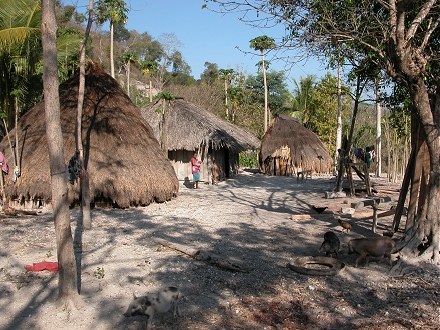
22/9/04 All rubbish is burnt ready for the wet. The air
is heavy with smoke before the rains. Phlegm and sore throats, coughing,
but still the burning continues. Kupang was our first Asian experience, 12
years ago with our three children we crossed to Bali overland with connecting
boats. There were almost no tourists then, as now, following the Bali bombing
they have fled this region. A few ex-pat Australians have retired here, usually
a depressing bunch, outcasting themselves from their home country, complaining
of their's and the world's ills whilst sitting at the bar slowly waiting to
die. Kupang is the region's capital, bustling, busy and noisy, a seaport connecting
islands of the archipelago.
23/9/04 We were informed yesterday that there was a ferry
to Larantuka on the island of Flores leaving at 4 pm today. We had driven
to the wharf 13 km west of town yesterday just to make sure. Arriving at
2 pm today to buy the ticket we were told it had been delayed, now arriving
at 5 pm. It finally arrived at 6-30, when we, along with 300 people, four
small trucks, twenty motorcycles, ten horses and half a dozen cows, and
tons of baggage boarded, we left at 8 pm, four hours late, not bad for "rubber
time" (elastic stretch).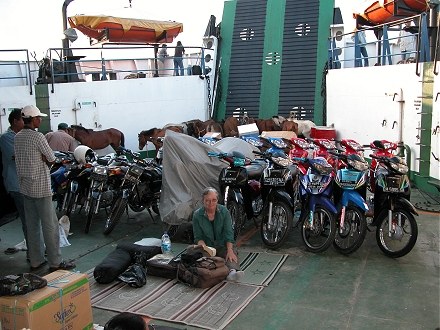 We were offered a 40 mm thick vinyl covered foam mattress to sleep on,
amidst forty others the same, on a raised platform, behind 200 plastic chairs
on the main deck, with TV blaring and cigarette smoke thick. We chose, along
with about 1/3 rd of the passengers to sleep on the vehicle deck, between
trucks and horses. We had purchased two woven mats earlier and in quieter,
fresher air, bunked down on the steel deck.
We were offered a 40 mm thick vinyl covered foam mattress to sleep on,
amidst forty others the same, on a raised platform, behind 200 plastic chairs
on the main deck, with TV blaring and cigarette smoke thick. We chose, along
with about 1/3 rd of the passengers to sleep on the vehicle deck, between
trucks and horses. We had purchased two woven mats earlier and in quieter,
fresher air, bunked down on the steel deck.
24/9/04 Despite it's steel hardness we slept reasonably
well waking early to the drone of the boat's engines and the queue to the
toilet, also a shower room, everyone freshening up before departing at 8.30
am. The last few hours the ferry meandered, weaving through small islands,
volcanoes mostly, their conical peaks in the clouds, their slopes slightly
hidden in the smoky haze. The oceans the total absorber of rubbish from disposable
nappies, plastic bottles, plastic bags and food containers, thrown overboard
to join a wider array of garbage washed from villages and towns in every rain
storm. There are no organized garbage disposal or collection facilities. The
best we have seen is a concrete pit or bin set alight when full. We booked into a losmen, cheap family run hotel, recovered from the boat
crossing and walked the town of Larantuka. It's back streets devoid of urban
planning or building codes where another storey or room is just attached
when needed, where roads don't rise as high up the hillside as houses and
water is drawn from a leak in the mains water pipe. Sewage treatment is non
existent, disappearing somewhere underground and a lot of water is drawn
from ground wells for washing.
We booked into a losmen, cheap family run hotel, recovered from the boat
crossing and walked the town of Larantuka. It's back streets devoid of urban
planning or building codes where another storey or room is just attached
when needed, where roads don't rise as high up the hillside as houses and
water is drawn from a leak in the mains water pipe. Sewage treatment is non
existent, disappearing somewhere underground and a lot of water is drawn
from ground wells for washing.
25/9/04 Indonesia's population is 90% Muslim however on
the islands of Timor and Flores the majority are Catholic Christians. In
some areas there seems to be a race on to build new, bigger and better Mosques
or Churches, almost a competition. Outwardly, apart from a few women wearing
head-dresses, it is difficult to distinguish the difference. The obvious sign
in a village is the presence of pigs. Muslims consider them dirty and will
not keep nor eat them. The island of Flores is volcanic, grasses for thatch
don't grow as much so palm leaves and bamboo are preferred traditional house
building materials. Small bricks are also made from the soils, fired in backyard
kilns. The higher fertility and rainfall produce some exotic foods like, jackfruit,
sapote, jambu, loquat and passion fruits. Cashews and coffee are grown in
the mountains. Just 110 km towards Maumere, bamboo huts on the beach front.
$US 4.00 a double including breakfast allured us to relax for another day.
With meals averaging another dollar each it will be difficult to leave.
The higher fertility and rainfall produce some exotic foods like, jackfruit,
sapote, jambu, loquat and passion fruits. Cashews and coffee are grown in
the mountains. Just 110 km towards Maumere, bamboo huts on the beach front.
$US 4.00 a double including breakfast allured us to relax for another day.
With meals averaging another dollar each it will be difficult to leave.
26/9/04 The road meandered, twisting and turning around
volcanic peaks and valleys. The light traffic moves at about 40 km/hr, motorcycles
a little faster, buses and trucks slower. We have long learnt that to go too
much faster than local traffic surprises people, animals and other vehicles
and becomes dangerous. Our loud exhaust gives ample warning of our arrival
most times, helping to clear the road ahead. Fuel is available in litre bottles
everywhere, a little more expensive than at the few petrol stations which
often have queues. We stopped at a couple of traditional villages, were welcomed
and could exchange a long look at the motorcycle for an equally long look
of the village.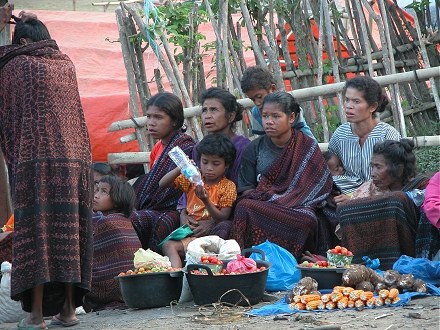 The cost and effort of maintaining high labour houses and high labour clothing
taking its toll. Younger people even in more traditional areas are wearing
western clothes. The heavy sarong like, ikat weaving, popular with tourists
and still worn and hand woven by women the most obvious traditional dress.
However it is now rarely hand spun or naturally died. Traditional villages
charge tourists an entrance fee to help offset the cost of maintenance and
run the risk of losing tradition to tourism. Passed through Maumere where
less than two weeks ago a volcano erupted showering the area in ash, nothing
to be seen today. Moved onto Moni, a rice growing village, brought to tourist
prominence by the three coloured lakes in it's nearby volcanic craters of
Kelimutu Mountain.
The cost and effort of maintaining high labour houses and high labour clothing
taking its toll. Younger people even in more traditional areas are wearing
western clothes. The heavy sarong like, ikat weaving, popular with tourists
and still worn and hand woven by women the most obvious traditional dress.
However it is now rarely hand spun or naturally died. Traditional villages
charge tourists an entrance fee to help offset the cost of maintenance and
run the risk of losing tradition to tourism. Passed through Maumere where
less than two weeks ago a volcano erupted showering the area in ash, nothing
to be seen today. Moved onto Moni, a rice growing village, brought to tourist
prominence by the three coloured lakes in it's nearby volcanic craters of
Kelimutu Mountain.
27/9/04 Tourists used to flock here but two years ago
the Bali bombings frightened most away and the subsequent further two bomb
blasts in Jakarta haven't helped them return. We rose before sunrise and
rode to the parking area, walking at dawn to the coloured lakes just as the
sun was breaking through the thick smoke horizon.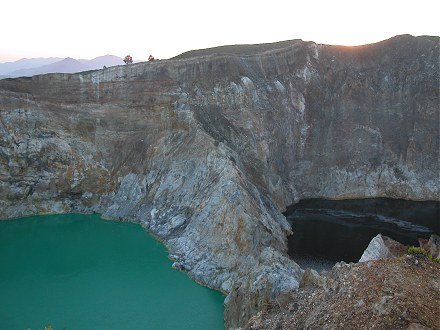 The other ten tourists in town were also here, sunrise the best time to
see the magnificent black, turquoise and clear volcanic lakes. Monday is
market day in Moni, ladies bring whatever they have grown or made to sell.
An array of vegetable and Ikat weaving. Firewood is also brought down from
the slash and burn agriculture carried out in the surrounding mountains.
At $US 0.50 cents a large bundle it has to be cut, dried, stacked, carted,
sold and delivered to the purchaser's house, a hard lifestyle. We rode to
Ende, just 50 km. A ferry sank in the harbour here just yesterday. While
loading, trucks shifted tilting the ferry, taking on water it capsized in
the harbour killing one person. We were here to check out ferries from Java
to Pontianak in Borneo, the route we want to follow in a couple of weeks.
The shipping agent Prima Vista runs these ferries, catering for vehicles
and passengers, they were incredibly helpful, especially in providing information
this far away, however the October schedule doesn't come out until October
making forward planning difficult.
The other ten tourists in town were also here, sunrise the best time to
see the magnificent black, turquoise and clear volcanic lakes. Monday is
market day in Moni, ladies bring whatever they have grown or made to sell.
An array of vegetable and Ikat weaving. Firewood is also brought down from
the slash and burn agriculture carried out in the surrounding mountains.
At $US 0.50 cents a large bundle it has to be cut, dried, stacked, carted,
sold and delivered to the purchaser's house, a hard lifestyle. We rode to
Ende, just 50 km. A ferry sank in the harbour here just yesterday. While
loading, trucks shifted tilting the ferry, taking on water it capsized in
the harbour killing one person. We were here to check out ferries from Java
to Pontianak in Borneo, the route we want to follow in a couple of weeks.
The shipping agent Prima Vista runs these ferries, catering for vehicles
and passengers, they were incredibly helpful, especially in providing information
this far away, however the October schedule doesn't come out until October
making forward planning difficult.
28/9/04 The smoke in the air finally getting to my throat,
coughing, red raw and sore.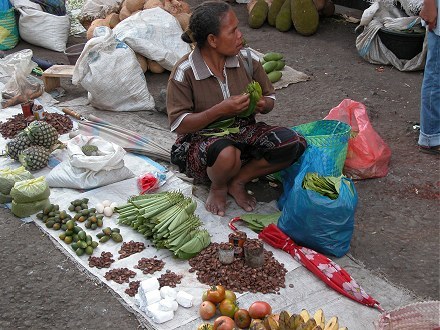 Headed into the mountains, Bajawa. First alongside the ocean where people
collected beach stones, pale blue and rounded by the waves. Bagged up along
the road waiting for trucks and sale where people have money for gardens.
Bajawa at 1500 metres is cool. After 10 nights of one night stands we relaxed
in the afternoon deciding to spend two nights here. Each indigenous society
seems to produce its own recreational drug. In this part of Indonesia it
is beetlenut, collected from a palm tree, mixed with lime and wrapped in
a green leaf and chewed, and chewed, until the red juice stains the teeth
and saliva it produces a mild narcotic effect. Prolonged use rots the teeth
giving a reddish black gaping smile. In this region it is predominantly used
by the women.
Headed into the mountains, Bajawa. First alongside the ocean where people
collected beach stones, pale blue and rounded by the waves. Bagged up along
the road waiting for trucks and sale where people have money for gardens.
Bajawa at 1500 metres is cool. After 10 nights of one night stands we relaxed
in the afternoon deciding to spend two nights here. Each indigenous society
seems to produce its own recreational drug. In this part of Indonesia it
is beetlenut, collected from a palm tree, mixed with lime and wrapped in
a green leaf and chewed, and chewed, until the red juice stains the teeth
and saliva it produces a mild narcotic effect. Prolonged use rots the teeth
giving a reddish black gaping smile. In this region it is predominantly used
by the women.
29/9/04 Bamboo, in the mountains, is the most versatile
building material. A whole house can be constructed using only bamboo. Large
sticks for posts, bearers and roofing. Split and flattened for walls and floors.
Split in halves for a waterproof roof, under and over like terracotta tiles.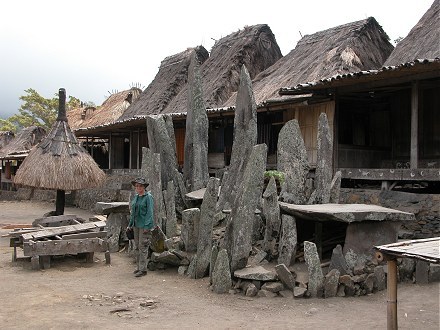 Small sticks cut into strips and woven for mats and ceiling and wall decorations.
Doors and window shutters also flattened bamboo, framed by the whole sticks.
Furniture, chairs and tables made in the same fashion as well as beds. Even
the water can be reticulated to the house using split bamboo as an open pipe.
We headed south to the touristed traditional village of Bena, one of a few
in the region, 20 km along a rough road, The small entry fee going towards
bringing water to the village. Ikat weaving for sale in tourist demanded colours
and patterns. A generator house, partially disguised and concrete bathrooms
new additions to the tradition. The houses externally and the village courtyard
still kept in a semblance of the past. As tourists bring money the village
becomes wealthy and rightly wants the trappings that come with wealth. Understanding
the need to continue sufficient traditions that the tourists pay to see the
village provides this. An interesting adaptation of "traditional" use of
tourists.
Small sticks cut into strips and woven for mats and ceiling and wall decorations.
Doors and window shutters also flattened bamboo, framed by the whole sticks.
Furniture, chairs and tables made in the same fashion as well as beds. Even
the water can be reticulated to the house using split bamboo as an open pipe.
We headed south to the touristed traditional village of Bena, one of a few
in the region, 20 km along a rough road, The small entry fee going towards
bringing water to the village. Ikat weaving for sale in tourist demanded colours
and patterns. A generator house, partially disguised and concrete bathrooms
new additions to the tradition. The houses externally and the village courtyard
still kept in a semblance of the past. As tourists bring money the village
becomes wealthy and rightly wants the trappings that come with wealth. Understanding
the need to continue sufficient traditions that the tourists pay to see the
village provides this. An interesting adaptation of "traditional" use of
tourists.
30/9/04 The road through Ruteng to Labuanbajo continues
its winding mountain path. Although potholed Indonesia is spending money
on roadworks here.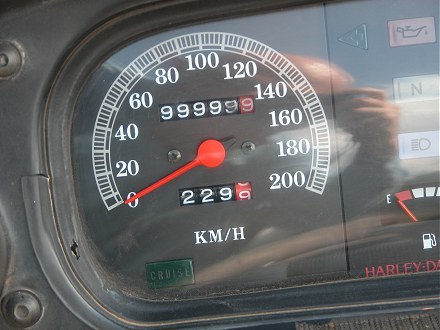 Sections are repaired, hotmix laid, road drainage built and culverts and
bridges widened. Most is laboriously done by hand. Suitably sized rocks
quarried, placed one by one in a hand picked and squared pothole. Tar from
a drum heated over locally cut firewood and poured over the rocks to make
a patch. Even though the road is being upgraded there is no machinery to
excavate to straighten corners, which is perhaps good as the vehicles go
as fast here as the roads permit. We stopped part way along the road to photograph
the speedometer turning over for the fourth time, 400,000 km's.
Sections are repaired, hotmix laid, road drainage built and culverts and
bridges widened. Most is laboriously done by hand. Suitably sized rocks
quarried, placed one by one in a hand picked and squared pothole. Tar from
a drum heated over locally cut firewood and poured over the rocks to make
a patch. Even though the road is being upgraded there is no machinery to
excavate to straighten corners, which is perhaps good as the vehicles go
as fast here as the roads permit. We stopped part way along the road to photograph
the speedometer turning over for the fourth time, 400,000 km's.
1/10/04 Labuanbajo is about as far east as most people
get, incorporating Bali to Komodo in their holiday. This is the first place
that tourism is as busy as on our visit here 12 years ago. The boat trips
are more varied, the boats better and the accommodation more upmarket than
before. We had planned to do a one day trip to Rinca Island, with more easily
sighted komodo dragons than the island of Komodo. During the negotiations
another group of tourists advised us of the possibility to snorkel with
manta rays, an opportunity not to be missed. With negotiations and trying
to share the costs of the trip with other tourists it took all day till the
final arrangements.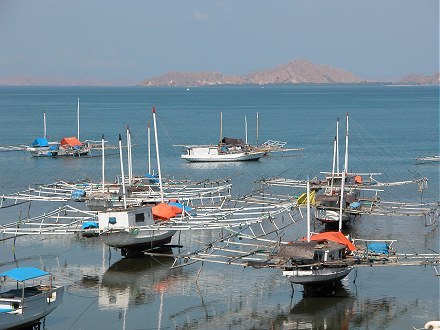 A French couple we had met a few days ago decided to change their plans,
cancelling their previous boat, they negotiated for the four of us, a two
day, one night trip, food included $US 33.00 each person, leaving tomorrow
at 6 am.
A French couple we had met a few days ago decided to change their plans,
cancelling their previous boat, they negotiated for the four of us, a two
day, one night trip, food included $US 33.00 each person, leaving tomorrow
at 6 am.
2/10/04 Surprisingly the boat left on time. An 18 metre,
1 yr old, locally built (it took the captain a year to build) local design,
a slightly modified fishing boat. The flat front deck for relaxing and sleeping,
a wheel house, toilet and cook area at the stern. Built from timber from Borneo
and powered by a Japanese diesel with no gearbox. If the engine runs, the
propellor runs, no reverse, no neutral. The two hour trip to Rinca passes
between many islands in flat water, some inhabited, others not, sandy beaches
and strong currents. On arrival there was one komodo dragon to greet us as
we left the jetty and a further eight living around the ranger's houses. These
are fed scraps ensuring the tourists get to see some komodo on their visit.
The dragons grow up to three metres in length and their strong mouth bacteria
will eventually kill any animal they get a chance to bite. Water buffalo,
deer, monkey and pigs the main wild game on Rinca where about 1000 dragons
live naturally.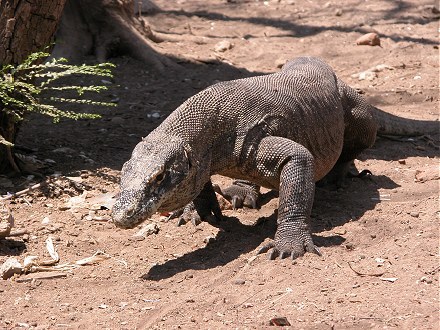 We spotted only one on our two hour walk, a mother guarding her nest of
eggs, but also saw many monkeys and deer. The boat, another two hours slow
motoring, took us to Komodo Island and Red Beach for snorkelling in a protected
area of corals. Both fish and coral varieties were excellent. The evening
near a flying fox (bat) daytime rest area where we snorkelled ashore into
the mangroves for a closer look at the browner cousins of the Australian
fruit bats. Two fish meals for the day and after watching the stars over
bintang beer and arak (palm wine) and sprite we slept on a 25 mm mattress
on the deck.
We spotted only one on our two hour walk, a mother guarding her nest of
eggs, but also saw many monkeys and deer. The boat, another two hours slow
motoring, took us to Komodo Island and Red Beach for snorkelling in a protected
area of corals. Both fish and coral varieties were excellent. The evening
near a flying fox (bat) daytime rest area where we snorkelled ashore into
the mangroves for a closer look at the browner cousins of the Australian
fruit bats. Two fish meals for the day and after watching the stars over
bintang beer and arak (palm wine) and sprite we slept on a 25 mm mattress
on the deck.
3/10/04 The captain was up at 4 am making breakfast and
by 5 am we were underway, another two hours to the south of Komodo Island.
The outgoing tide causing current waves and whirlpools between islands.
Manta Alley is a quiet section of water sheltered by a couple of small islands
offshore. It's reported the manta rays are here all year feeding on plankton
congregated by the currents. The boat is not allowed to anchor and just drifted
as we snorkelled. We could see the black and white tips of the manta's fins
from the boat but almost as soon as we entered the water the immense size,
initially frightening, struck us.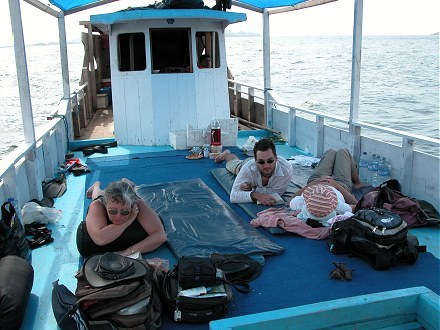 Up to three metres across with the plankton gathering mouth a metre across.
Three or four manta would be seen at once, slowly moving towards us then
when less than two metres away they would alter course displaying their white
underbellies. The water was cold, especially for the tropics, perhaps 22 degrees.
We watched for ages as individuals or small groups seemingly flew past in
slow motion flapping enormous wings. Cold, I decided to follow a group of
three, and for over 200 metres was the fourth in the procession. As they
rose close towards the surface I had to drop back from the third one as it
became so close I could have accidentally touched it. Eventually I had to
let them go as they continued feeding and I returned to the boat exhausted
but warm with adrenaline. One of the most amazing experiences of our travels.
We anchored nearby and snorkelled to Komodo Island where deer and pig were
sighted. Greg the French tourist also saw a Komodo whilst walking alone. We
returned to the manta spot only to find they had gone with the plankton at
the change of tide. Two were sighted on the other side of the island but despite
our enthusiastic search while snorkelling they disappeared into the depths.
A four hour boat trip back to Labuanbajo and exhausted we cleaned up and
washed for our departure tomorrow.
Up to three metres across with the plankton gathering mouth a metre across.
Three or four manta would be seen at once, slowly moving towards us then
when less than two metres away they would alter course displaying their white
underbellies. The water was cold, especially for the tropics, perhaps 22 degrees.
We watched for ages as individuals or small groups seemingly flew past in
slow motion flapping enormous wings. Cold, I decided to follow a group of
three, and for over 200 metres was the fourth in the procession. As they
rose close towards the surface I had to drop back from the third one as it
became so close I could have accidentally touched it. Eventually I had to
let them go as they continued feeding and I returned to the boat exhausted
but warm with adrenaline. One of the most amazing experiences of our travels.
We anchored nearby and snorkelled to Komodo Island where deer and pig were
sighted. Greg the French tourist also saw a Komodo whilst walking alone. We
returned to the manta spot only to find they had gone with the plankton at
the change of tide. Two were sighted on the other side of the island but despite
our enthusiastic search while snorkelling they disappeared into the depths.
A four hour boat trip back to Labuanbajo and exhausted we cleaned up and
washed for our departure tomorrow.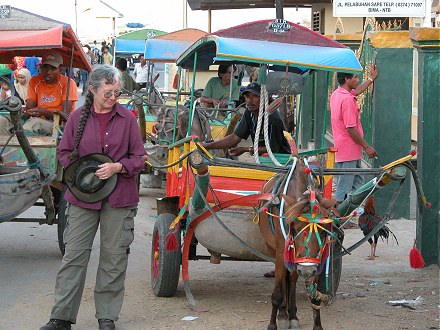
4/10/04 The daily 8 am ferry to Sape left at 9 am. It's
the first time we have been asked to buy two tickets for the motorcycle,
it being so large compared with the small local bikes. The seven hour trip
around the top of Komodo island passed quickly. The crew could not be seen,
asleep in cabins above. They were there to collect the tickets and bribes
from those who had no tickets, quite a percentage. The downstairs toilets
were unpleasant. One full of luggage, one without a door and the other two
without water. I was annoyed enough to approach the captain on the bridge
who only suggested I could use the more opulent crew toilets. This was not
the point, the paying passengers needed water to flush toilets and the many
Muslims to wash themselves. Water was turned on but the passengers then used
it for a shower and within an hour there was again no water. The Mushollah,
a room set aside for prayer, was used as an area for sleeping. The 1st class
chairs, upholstered, were torn and broken, the essential TV worked. It is
appalling how the crew in their bright uniforms live in relative luxury ripping
off the company while the paying passengers have to put up with a lack of
maintenance due to insufficient money.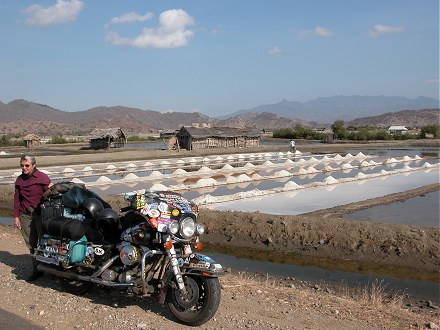 We stayed in a small port town on the boat's arrival, just outside of Sape
where the houses are tainted with Dutch design and fish dry in the streets
on woven mats. Horse drawn wagons are still the main people and goods carriers
here.
We stayed in a small port town on the boat's arrival, just outside of Sape
where the houses are tainted with Dutch design and fish dry in the streets
on woven mats. Horse drawn wagons are still the main people and goods carriers
here.
5/10/04 310 km to Sumbawa Besar, the capital of Sumbawa
the island. The road straighter, enough for top gear once or twice, but
still a six hour trip. Macaque monkeys were often roadside, eating food dropped
by passing motorists. Animals were again allowed to wander freely, goats,
chickens, and buffalo grazed the roadside. Agricultural areas fenced off unlike
in Flores where the animals were tethered not free roaming. We passed fish
farming and salt drying ponds in the lowlands, rice fields where land was
flat and wet enough and slash and burn in the hills. Wood slab and tiled roofed
houses the majority lining the road. The red and white Indonesian flag proudly
flying everywhere, even most school uniforms the same colours. A predominantly
Muslim island the head scarf worn by most women. Internet and food from street
warungs in the evening.
6/10/04 Bicycle rickshaws have started to appear. The three wheeled event, passengers sitting out front, the rider pedalling
from behind. Used mainly to and from the markets they can carry more than
a motorcycle and are cheaper than a horse cart. We hired one for an hour,
toured to the Sultan's Palace, an old wooden building, restored more than
new but still a bit dilapidated. In the afternoon the street we were walking
became almost empty of traffic. The police were out, perhaps 20 of them,
at one intersection checking registration and licences. Most motorcyclists
simply U turn on seeing them, cars pulled over, and people were warning others.
We assumed most people don't have the proper papers for their vehicles or
don't have a drivers license. Over dinner we knew when the police had gone,
the traffic noise rose to normal levels.
The three wheeled event, passengers sitting out front, the rider pedalling
from behind. Used mainly to and from the markets they can carry more than
a motorcycle and are cheaper than a horse cart. We hired one for an hour,
toured to the Sultan's Palace, an old wooden building, restored more than
new but still a bit dilapidated. In the afternoon the street we were walking
became almost empty of traffic. The police were out, perhaps 20 of them,
at one intersection checking registration and licences. Most motorcyclists
simply U turn on seeing them, cars pulled over, and people were warning others.
We assumed most people don't have the proper papers for their vehicles or
don't have a drivers license. Over dinner we knew when the police had gone,
the traffic noise rose to normal levels.
7/10/04 A two hour ride and another ferry, to the island
of Lombok. This time the ferry corruption scam was to issue us with a ticket
stub, not the full ticket. On insistence a new ticket book was found and
the correct ticket issued. A ride on ride off ferry the lower deck was sealed
for water tightness, however the engine room doors were open and with vehicles
parked so close they could not be swung shut if needed in an emergency, meaning
the ferry would sink. Lombok is greener and more industrious. The subsistence
farming gone and agriculture more organized. Crops more varied and markets
bigger being closer to Bali and Java. We ended up at Sengiggi Beach, the Bali
equivalent of Kuta Beach, a constructed western holiday place with low key
resort hotels. However the lack of tourists leaves the place feeling lonely
and a bit tacky and shabby. The few touts almost outnumber tourists and are
pushy to sell. Unless you come in a group you would be the only one in the
restaurant or bar.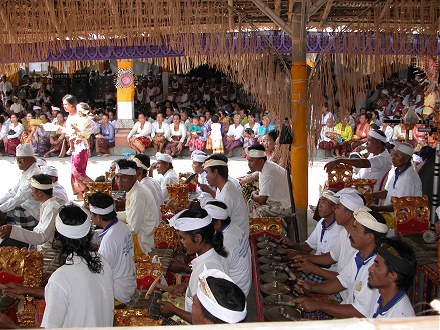
8/10/04 The motorcycle was flown to Bali in 1996 and returned
today by ferry from Lombok. Another ferry crossing, five hours, one hour
waiting offshore until the wharf was empty. Ride on ride off, again we had
to pay for two motorcycles, ours so much bigger than the local's. Perhaps
the biggest change I have seen in Indonesia is the number of motorcycles
on the road. We saw two minor accidents yesterday, both involving motorcycles.
Two locals we talked to said in separate incidents that they had each killed
a motorcyclist, one as a pillion the other hit with his car. No helmets and
most unlicensed. In each case a payment of $US 1500 had to be paid to the
victim's family and a further $US 500 bribe to the police to clear the matter
from going to court. We stayed in the port, beach side town of Padangbai.
A pleasant mix of local fishermen and tourists. The weekly boat from Surabaya,
Java to Pontianak (Borneo) leaves Tuesday and we decided to hurry through
this area as we have been here twice before and catch the next boat in four
day's time.
9/10/04 Riding through Denpasar and a police siren from
behind, the first we have heard, forced us off the road along with all other
traffic. It was a Harley-Davidson police bike leading the Bali Harley-Davidson
club on a ride. 15 or more bikes zapping through busy traffic with the police
escort.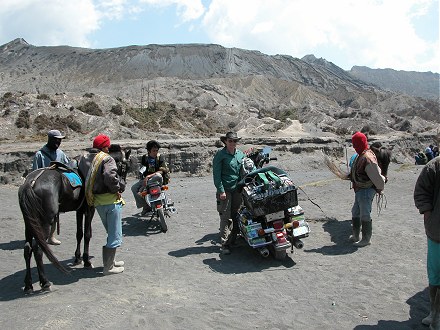 We quickly joined in the back taking full advantage of the cleared road
and faster riding. After about 10 km they stopped for fuel and we had a short
opportunity to talk. Unfortunately they were deviating from our direction
and in a further 5 km we waved goodbye. All of their club rides have police
escorts to allow quick passage, running red lights and keeping the group
together. A use of the police unthinkable in the west. At Tabanan the Hindu
festival at the local temple, supposedly held only every 30 years was in
it's last day of the month long celebration. The temple itself dressed up,
the people in their finest and most colourful robes making offerings to their
god Vishnu. Gamelan music was being played by an orchestra of 50 people.
We watched and listened to the music over lunch at a nearby warung (restaurant).
Further west to Gilimanuk and a ferry to Java, 30 minutes, taking an hour,
as there are more boats than wharf space and again we waited offshore for
a berth. The easternmost end of Java is heavily forested in planted teak
trees, and in light traffic we travelled 80 km to Situbondo.
We quickly joined in the back taking full advantage of the cleared road
and faster riding. After about 10 km they stopped for fuel and we had a short
opportunity to talk. Unfortunately they were deviating from our direction
and in a further 5 km we waved goodbye. All of their club rides have police
escorts to allow quick passage, running red lights and keeping the group
together. A use of the police unthinkable in the west. At Tabanan the Hindu
festival at the local temple, supposedly held only every 30 years was in
it's last day of the month long celebration. The temple itself dressed up,
the people in their finest and most colourful robes making offerings to their
god Vishnu. Gamelan music was being played by an orchestra of 50 people.
We watched and listened to the music over lunch at a nearby warung (restaurant).
Further west to Gilimanuk and a ferry to Java, 30 minutes, taking an hour,
as there are more boats than wharf space and again we waited offshore for
a berth. The easternmost end of Java is heavily forested in planted teak
trees, and in light traffic we travelled 80 km to Situbondo.
10/10/04 Just four months ago, unexpectedly, the steaming
crater of Mt Bromo exploded. Two people on it's rim were killed by flying
debris, others injured but many more escaped unhurt. The ash stripped leaves
and vegetation on its slopes, built up in blown sand dunes and is whipped
up by the strong winds even now getting into everything. We took the motorcycle
into the main caldera, 20 km in diameter, where three smaller volcanic cones
rise, including the one that recently erupted.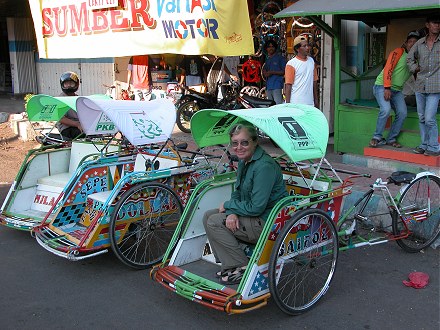 Looking in from the rim of the active cone we can see how much more enlarged
and deeper it is than on our past visits here. Now steaming quietly tourists
have returned, till the next explosion.
Looking in from the rim of the active cone we can see how much more enlarged
and deeper it is than on our past visits here. Now steaming quietly tourists
have returned, till the next explosion.
11/10/04 Leaving the cool mountain air for Surabaya, four
hours ride, the last 80 km taking three hours in jam packed traffic as motorcycles
are not allowed to use toll ways. The air thick with truck diesel fumes and
burnt oil of the two stroke motorcycles. Our bike ran hot, the oil pressure
light flickering on at idle, the starter motor crunchy with the engine so
hot and poor quality fuel. Luckily two men we asked directions from led us
on their motorcycle to our chosen hotel, the one way streets prolonging the
trip. Two and a half million people live here, the second largest city in
Indonesia, but the surrounding cities seem to have merged into one tight packed
sprawling city. We opted for a taxi to the Prima Vista boat company office
(Surabaya Ph 031 3294444 or Semarang 024 3581137 once weekly to each destination
from Pontianak) near the wharf to collect our tickets to Pontianak in Borneo.
Charged $US 43.00 each for the ensuite cabin and $US 80.00 for the motorcycle,
(again twice the price of a local bike, but a third the price of a car).
Later in the afternoon we walked the streets near our hotel, food stalls
line the pavement, constant traffic and noise. The old thought of the sheer
number of people the world is trying to cater for always there. The increasing
population and increasing demand on resources to us the greatest problem
on earth.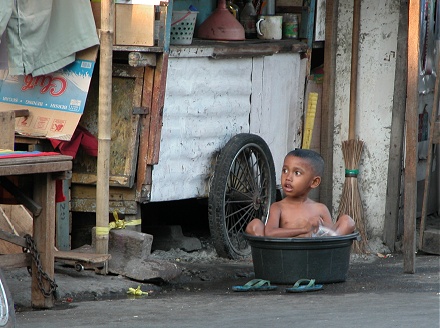

12/10/04 The canals/creeks flowing to the ocean through
town are now a soapy grey from washing water entering directly untreated
from households and street stalls. Amazingly they are still swarming with
fish living on small particles of human food. With no one prepared to eat
the fish they are adapted to the polluted waters. Plants grow profusely along
the banks fed by the rotting waste. When the rains come in a month or two
the open street drains will clog with rubbish built up during the dry. Slowly they will be cleared washing the plastic and decaying vegetable
matter out to sea. There are few havens here for locals. We pull back to
our hotel when we are overdosed on the teeming mass. Many have nowhere to
go, sleeping in their pedal rickshaws or on cardboard in the streets, protecting
their stalls. Children have few places to play, often locked in a small house
with no yard or garden, fronting busy streets. We stayed in our hotel till
1 pm check out and moved to the boat, KM Marisa Nusantara, boarding at 3
pm. Our luxury cabin, one of only two on the boat, has three rooms, bedroom,
ensuite and lounge dining area. Meals are brought to the cabin. Many other
non ensuite cabins exist but the vast majority, over 500 passengers, paying
almost half what we pay, simply get floor space on a raised platform, no
chairs, they can rent a foam mattress. Many choose to sleep outside or near
stair foyers, all crammed in tightly.
Slowly they will be cleared washing the plastic and decaying vegetable
matter out to sea. There are few havens here for locals. We pull back to
our hotel when we are overdosed on the teeming mass. Many have nowhere to
go, sleeping in their pedal rickshaws or on cardboard in the streets, protecting
their stalls. Children have few places to play, often locked in a small house
with no yard or garden, fronting busy streets. We stayed in our hotel till
1 pm check out and moved to the boat, KM Marisa Nusantara, boarding at 3
pm. Our luxury cabin, one of only two on the boat, has three rooms, bedroom,
ensuite and lounge dining area. Meals are brought to the cabin. Many other
non ensuite cabins exist but the vast majority, over 500 passengers, paying
almost half what we pay, simply get floor space on a raised platform, no
chairs, they can rent a foam mattress. Many choose to sleep outside or near
stair foyers, all crammed in tightly.
13/10/04 A 40 hour, two night trip, this is the first
time we have chosen to take such comfort on a boat, indeed the first time
this level of comfort has existed to be taken. Leaving our personal space
occasionally to see how the other passengers were managing, most were resting,
avoiding seasickness despite a smooth voyage, preying in the Mushollah or
eating snacks in the restaurant. The floor area staked out last night guarded
for today and tonight. Ramadan, the holy fasting month begins tomorrow. Many
people are returning home to their villages to spend time with family for
the fasting and celebrations that follow.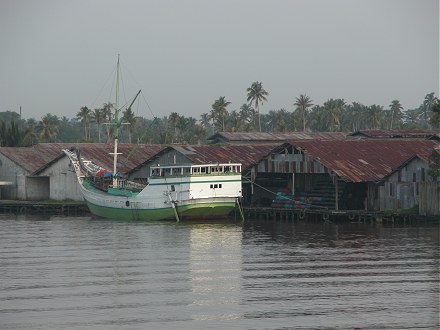
14/10/04 The boat was travelling north but early morning
swung east and up the Kapuas River for the next few hours. Passing through
brown water the banks were lush green as we approach the equator and the
wet season. Boats and stilt houses dotted the rivers edge, lumber yards milled
timber. Pontianak is a pass through town, a connecting road to Malaysia from
Indonesia. The people are traditionally made up of Dayak and Malays but more
recently Javans have emigrated to the more slightly populated area. The lifestyle
here is wealthier, and more expensive. The Malay influence brings more Chinese
style food. The city is spread out, land is available here. There are relatively
few microlets (minibuses), most people own a motorcycle or motorcar. We visited
the tourist office, almost useless and the Museum of West Kalimantan, very
interesting and a good guide.
15/10/04 Morning maintenance on the bike, cut the windscreen
down about 3 cm as it has become opaque, difficult to see through, hard
to see potholes. Checked the engine to primary oil seal, recently replaced,
still leaking oil from the primary to engine. Old Pontianak, at the confluence
of the two rivers, is stilt houses connected by wooden boardwalks and narrow
canals.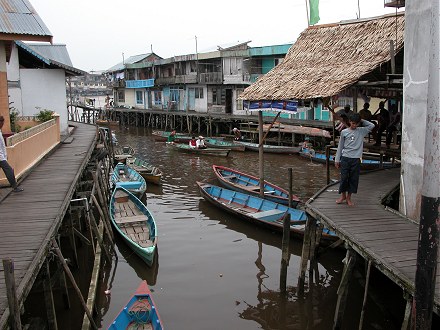 Small boats ferry people from the main city. We wandered the rickety boardwalks,
slowly rotting away, as are the wooden stilt houses, remainders of a past
era. People still live here, washing and bathing in the brown river water.
The Sultan's palace and Royal Mosque from the 18th century attract visitors
and worshipers.
Small boats ferry people from the main city. We wandered the rickety boardwalks,
slowly rotting away, as are the wooden stilt houses, remainders of a past
era. People still live here, washing and bathing in the brown river water.
The Sultan's palace and Royal Mosque from the 18th century attract visitors
and worshipers.
16/10/04 The one road out of town follows the coast north
through low lying swampy canal land. Wooden houses on stilts or land fill
edge the road, rice fields between. Indonesia is so vast they were harvesting
rice in the east and are just planting it now to the north of the equator.
The good road headed inland, unlogged mountains surrounded some slash and
burn dryland and every flatland creek was channelled to rice fields. We
were going to take two days to the border but with light traffic we moved
quickly. Small rubber and enormous palm oil tree plantations lined the roadside
as the population started to thin. The whole region has a frontier feel.
Enormous new houses are situated next to bamboo huts. One perhaps had the
timber contract, one planted rice between tree stumps by hand, no buffalo
or machinery to till the soil. Immigration stamped us out at the border
and customs didn't need to see us. As we hadn't had the carnet signed on
entry to Indonesia we didn't need to see them, and just drove through.
Move with us to Malaysia
 21/9/04 On the Indonesian side customs were not interested
in the carnet, claimed it unnecessary, no searches but a wait till immigration
opened at 9.00 am Indonesian time, one hour behind East Timor time. So we
passed through without any special paperwork for the motorcycle, just the
"sticker" registration paper was asked to be sighted. Immediately the economic
situation was improved. Roadworks, houses being painted, industry moving.
More traffic, and no wonder with petrol at US$0.20 cents a litre, and motorcycle
taxies everywhere. An enormous drop in prices had occurred across the border,
large bottled water US$0.30 cents, substantial lunch US$0.75 cents each, tonight's
accommodation, basic US$3.30 a double. The road wound through the hills,
twisting, turning through villages of bamboo walls and thatch or iron roofs..
Some having large gazebo's in the front yard, thatched roofed, a relax, meeting
place to spend siesta or the evening. Soe for the night.
21/9/04 On the Indonesian side customs were not interested
in the carnet, claimed it unnecessary, no searches but a wait till immigration
opened at 9.00 am Indonesian time, one hour behind East Timor time. So we
passed through without any special paperwork for the motorcycle, just the
"sticker" registration paper was asked to be sighted. Immediately the economic
situation was improved. Roadworks, houses being painted, industry moving.
More traffic, and no wonder with petrol at US$0.20 cents a litre, and motorcycle
taxies everywhere. An enormous drop in prices had occurred across the border,
large bottled water US$0.30 cents, substantial lunch US$0.75 cents each, tonight's
accommodation, basic US$3.30 a double. The road wound through the hills,
twisting, turning through villages of bamboo walls and thatch or iron roofs..
Some having large gazebo's in the front yard, thatched roofed, a relax, meeting
place to spend siesta or the evening. Soe for the night.
 We were offered a 40 mm thick vinyl covered foam mattress to sleep on,
amidst forty others the same, on a raised platform, behind 200 plastic chairs
on the main deck, with TV blaring and cigarette smoke thick. We chose, along
with about 1/3 rd of the passengers to sleep on the vehicle deck, between
trucks and horses. We had purchased two woven mats earlier and in quieter,
fresher air, bunked down on the steel deck.
We were offered a 40 mm thick vinyl covered foam mattress to sleep on,
amidst forty others the same, on a raised platform, behind 200 plastic chairs
on the main deck, with TV blaring and cigarette smoke thick. We chose, along
with about 1/3 rd of the passengers to sleep on the vehicle deck, between
trucks and horses. We had purchased two woven mats earlier and in quieter,
fresher air, bunked down on the steel deck.  We booked into a losmen, cheap family run hotel, recovered from the boat
crossing and walked the town of Larantuka. It's back streets devoid of urban
planning or building codes where another storey or room is just attached
when needed, where roads don't rise as high up the hillside as houses and
water is drawn from a leak in the mains water pipe. Sewage treatment is non
existent, disappearing somewhere underground and a lot of water is drawn
from ground wells for washing.
We booked into a losmen, cheap family run hotel, recovered from the boat
crossing and walked the town of Larantuka. It's back streets devoid of urban
planning or building codes where another storey or room is just attached
when needed, where roads don't rise as high up the hillside as houses and
water is drawn from a leak in the mains water pipe. Sewage treatment is non
existent, disappearing somewhere underground and a lot of water is drawn
from ground wells for washing.  The higher fertility and rainfall produce some exotic foods like, jackfruit,
sapote, jambu, loquat and passion fruits. Cashews and coffee are grown in
the mountains. Just 110 km towards Maumere, bamboo huts on the beach front.
$US 4.00 a double including breakfast allured us to relax for another day.
With meals averaging another dollar each it will be difficult to leave.
The higher fertility and rainfall produce some exotic foods like, jackfruit,
sapote, jambu, loquat and passion fruits. Cashews and coffee are grown in
the mountains. Just 110 km towards Maumere, bamboo huts on the beach front.
$US 4.00 a double including breakfast allured us to relax for another day.
With meals averaging another dollar each it will be difficult to leave.
 The cost and effort of maintaining high labour houses and high labour clothing
taking its toll. Younger people even in more traditional areas are wearing
western clothes. The heavy sarong like, ikat weaving, popular with tourists
and still worn and hand woven by women the most obvious traditional dress.
However it is now rarely hand spun or naturally died. Traditional villages
charge tourists an entrance fee to help offset the cost of maintenance and
run the risk of losing tradition to tourism. Passed through Maumere where
less than two weeks ago a volcano erupted showering the area in ash, nothing
to be seen today. Moved onto Moni, a rice growing village, brought to tourist
prominence by the three coloured lakes in it's nearby volcanic craters of
Kelimutu Mountain.
The cost and effort of maintaining high labour houses and high labour clothing
taking its toll. Younger people even in more traditional areas are wearing
western clothes. The heavy sarong like, ikat weaving, popular with tourists
and still worn and hand woven by women the most obvious traditional dress.
However it is now rarely hand spun or naturally died. Traditional villages
charge tourists an entrance fee to help offset the cost of maintenance and
run the risk of losing tradition to tourism. Passed through Maumere where
less than two weeks ago a volcano erupted showering the area in ash, nothing
to be seen today. Moved onto Moni, a rice growing village, brought to tourist
prominence by the three coloured lakes in it's nearby volcanic craters of
Kelimutu Mountain.  The other ten tourists in town were also here, sunrise the best time to
see the magnificent black, turquoise and clear volcanic lakes. Monday is
market day in Moni, ladies bring whatever they have grown or made to sell.
An array of vegetable and Ikat weaving. Firewood is also brought down from
the slash and burn agriculture carried out in the surrounding mountains.
At $US 0.50 cents a large bundle it has to be cut, dried, stacked, carted,
sold and delivered to the purchaser's house, a hard lifestyle. We rode to
Ende, just 50 km. A ferry sank in the harbour here just yesterday. While
loading, trucks shifted tilting the ferry, taking on water it capsized in
the harbour killing one person. We were here to check out ferries from Java
to Pontianak in Borneo, the route we want to follow in a couple of weeks.
The shipping agent Prima Vista runs these ferries, catering for vehicles
and passengers, they were incredibly helpful, especially in providing information
this far away, however the October schedule doesn't come out until October
making forward planning difficult.
The other ten tourists in town were also here, sunrise the best time to
see the magnificent black, turquoise and clear volcanic lakes. Monday is
market day in Moni, ladies bring whatever they have grown or made to sell.
An array of vegetable and Ikat weaving. Firewood is also brought down from
the slash and burn agriculture carried out in the surrounding mountains.
At $US 0.50 cents a large bundle it has to be cut, dried, stacked, carted,
sold and delivered to the purchaser's house, a hard lifestyle. We rode to
Ende, just 50 km. A ferry sank in the harbour here just yesterday. While
loading, trucks shifted tilting the ferry, taking on water it capsized in
the harbour killing one person. We were here to check out ferries from Java
to Pontianak in Borneo, the route we want to follow in a couple of weeks.
The shipping agent Prima Vista runs these ferries, catering for vehicles
and passengers, they were incredibly helpful, especially in providing information
this far away, however the October schedule doesn't come out until October
making forward planning difficult.  Headed into the mountains, Bajawa. First alongside the ocean where people
collected beach stones, pale blue and rounded by the waves. Bagged up along
the road waiting for trucks and sale where people have money for gardens.
Bajawa at 1500 metres is cool. After 10 nights of one night stands we relaxed
in the afternoon deciding to spend two nights here. Each indigenous society
seems to produce its own recreational drug. In this part of Indonesia it
is beetlenut, collected from a palm tree, mixed with lime and wrapped in
a green leaf and chewed, and chewed, until the red juice stains the teeth
and saliva it produces a mild narcotic effect. Prolonged use rots the teeth
giving a reddish black gaping smile. In this region it is predominantly used
by the women.
Headed into the mountains, Bajawa. First alongside the ocean where people
collected beach stones, pale blue and rounded by the waves. Bagged up along
the road waiting for trucks and sale where people have money for gardens.
Bajawa at 1500 metres is cool. After 10 nights of one night stands we relaxed
in the afternoon deciding to spend two nights here. Each indigenous society
seems to produce its own recreational drug. In this part of Indonesia it
is beetlenut, collected from a palm tree, mixed with lime and wrapped in
a green leaf and chewed, and chewed, until the red juice stains the teeth
and saliva it produces a mild narcotic effect. Prolonged use rots the teeth
giving a reddish black gaping smile. In this region it is predominantly used
by the women.  Small sticks cut into strips and woven for mats and ceiling and wall decorations.
Doors and window shutters also flattened bamboo, framed by the whole sticks.
Furniture, chairs and tables made in the same fashion as well as beds. Even
the water can be reticulated to the house using split bamboo as an open pipe.
We headed south to the touristed traditional village of Bena, one of a few
in the region, 20 km along a rough road, The small entry fee going towards
bringing water to the village. Ikat weaving for sale in tourist demanded colours
and patterns. A generator house, partially disguised and concrete bathrooms
new additions to the tradition. The houses externally and the village courtyard
still kept in a semblance of the past. As tourists bring money the village
becomes wealthy and rightly wants the trappings that come with wealth. Understanding
the need to continue sufficient traditions that the tourists pay to see the
village provides this. An interesting adaptation of "traditional" use of
tourists.
Small sticks cut into strips and woven for mats and ceiling and wall decorations.
Doors and window shutters also flattened bamboo, framed by the whole sticks.
Furniture, chairs and tables made in the same fashion as well as beds. Even
the water can be reticulated to the house using split bamboo as an open pipe.
We headed south to the touristed traditional village of Bena, one of a few
in the region, 20 km along a rough road, The small entry fee going towards
bringing water to the village. Ikat weaving for sale in tourist demanded colours
and patterns. A generator house, partially disguised and concrete bathrooms
new additions to the tradition. The houses externally and the village courtyard
still kept in a semblance of the past. As tourists bring money the village
becomes wealthy and rightly wants the trappings that come with wealth. Understanding
the need to continue sufficient traditions that the tourists pay to see the
village provides this. An interesting adaptation of "traditional" use of
tourists.  Sections are repaired, hotmix laid, road drainage built and culverts and
bridges widened. Most is laboriously done by hand. Suitably sized rocks
quarried, placed one by one in a hand picked and squared pothole. Tar from
a drum heated over locally cut firewood and poured over the rocks to make
a patch. Even though the road is being upgraded there is no machinery to
excavate to straighten corners, which is perhaps good as the vehicles go
as fast here as the roads permit. We stopped part way along the road to photograph
the speedometer turning over for the fourth time, 400,000 km's.
Sections are repaired, hotmix laid, road drainage built and culverts and
bridges widened. Most is laboriously done by hand. Suitably sized rocks
quarried, placed one by one in a hand picked and squared pothole. Tar from
a drum heated over locally cut firewood and poured over the rocks to make
a patch. Even though the road is being upgraded there is no machinery to
excavate to straighten corners, which is perhaps good as the vehicles go
as fast here as the roads permit. We stopped part way along the road to photograph
the speedometer turning over for the fourth time, 400,000 km's.  A French couple we had met a few days ago decided to change their plans,
cancelling their previous boat, they negotiated for the four of us, a two
day, one night trip, food included $US 33.00 each person, leaving tomorrow
at 6 am.
A French couple we had met a few days ago decided to change their plans,
cancelling their previous boat, they negotiated for the four of us, a two
day, one night trip, food included $US 33.00 each person, leaving tomorrow
at 6 am.  We spotted only one on our two hour walk, a mother guarding her nest of
eggs, but also saw many monkeys and deer. The boat, another two hours slow
motoring, took us to Komodo Island and Red Beach for snorkelling in a protected
area of corals. Both fish and coral varieties were excellent. The evening
near a flying fox (bat) daytime rest area where we snorkelled ashore into
the mangroves for a closer look at the browner cousins of the Australian
fruit bats. Two fish meals for the day and after watching the stars over
bintang beer and arak (palm wine) and sprite we slept on a 25 mm mattress
on the deck.
We spotted only one on our two hour walk, a mother guarding her nest of
eggs, but also saw many monkeys and deer. The boat, another two hours slow
motoring, took us to Komodo Island and Red Beach for snorkelling in a protected
area of corals. Both fish and coral varieties were excellent. The evening
near a flying fox (bat) daytime rest area where we snorkelled ashore into
the mangroves for a closer look at the browner cousins of the Australian
fruit bats. Two fish meals for the day and after watching the stars over
bintang beer and arak (palm wine) and sprite we slept on a 25 mm mattress
on the deck.  Up to three metres across with the plankton gathering mouth a metre across.
Three or four manta would be seen at once, slowly moving towards us then
when less than two metres away they would alter course displaying their white
underbellies. The water was cold, especially for the tropics, perhaps 22 degrees.
We watched for ages as individuals or small groups seemingly flew past in
slow motion flapping enormous wings. Cold, I decided to follow a group of
three, and for over 200 metres was the fourth in the procession. As they
rose close towards the surface I had to drop back from the third one as it
became so close I could have accidentally touched it. Eventually I had to
let them go as they continued feeding and I returned to the boat exhausted
but warm with adrenaline. One of the most amazing experiences of our travels.
We anchored nearby and snorkelled to Komodo Island where deer and pig were
sighted. Greg the French tourist also saw a Komodo whilst walking alone. We
returned to the manta spot only to find they had gone with the plankton at
the change of tide. Two were sighted on the other side of the island but despite
our enthusiastic search while snorkelling they disappeared into the depths.
A four hour boat trip back to Labuanbajo and exhausted we cleaned up and
washed for our departure tomorrow.
Up to three metres across with the plankton gathering mouth a metre across.
Three or four manta would be seen at once, slowly moving towards us then
when less than two metres away they would alter course displaying their white
underbellies. The water was cold, especially for the tropics, perhaps 22 degrees.
We watched for ages as individuals or small groups seemingly flew past in
slow motion flapping enormous wings. Cold, I decided to follow a group of
three, and for over 200 metres was the fourth in the procession. As they
rose close towards the surface I had to drop back from the third one as it
became so close I could have accidentally touched it. Eventually I had to
let them go as they continued feeding and I returned to the boat exhausted
but warm with adrenaline. One of the most amazing experiences of our travels.
We anchored nearby and snorkelled to Komodo Island where deer and pig were
sighted. Greg the French tourist also saw a Komodo whilst walking alone. We
returned to the manta spot only to find they had gone with the plankton at
the change of tide. Two were sighted on the other side of the island but despite
our enthusiastic search while snorkelling they disappeared into the depths.
A four hour boat trip back to Labuanbajo and exhausted we cleaned up and
washed for our departure tomorrow.
 We stayed in a small port town on the boat's arrival, just outside of Sape
where the houses are tainted with Dutch design and fish dry in the streets
on woven mats. Horse drawn wagons are still the main people and goods carriers
here.
We stayed in a small port town on the boat's arrival, just outside of Sape
where the houses are tainted with Dutch design and fish dry in the streets
on woven mats. Horse drawn wagons are still the main people and goods carriers
here.  The three wheeled event, passengers sitting out front, the rider pedalling
from behind. Used mainly to and from the markets they can carry more than
a motorcycle and are cheaper than a horse cart. We hired one for an hour,
toured to the Sultan's Palace, an old wooden building, restored more than
new but still a bit dilapidated. In the afternoon the street we were walking
became almost empty of traffic. The police were out, perhaps 20 of them,
at one intersection checking registration and licences. Most motorcyclists
simply U turn on seeing them, cars pulled over, and people were warning others.
We assumed most people don't have the proper papers for their vehicles or
don't have a drivers license. Over dinner we knew when the police had gone,
the traffic noise rose to normal levels.
The three wheeled event, passengers sitting out front, the rider pedalling
from behind. Used mainly to and from the markets they can carry more than
a motorcycle and are cheaper than a horse cart. We hired one for an hour,
toured to the Sultan's Palace, an old wooden building, restored more than
new but still a bit dilapidated. In the afternoon the street we were walking
became almost empty of traffic. The police were out, perhaps 20 of them,
at one intersection checking registration and licences. Most motorcyclists
simply U turn on seeing them, cars pulled over, and people were warning others.
We assumed most people don't have the proper papers for their vehicles or
don't have a drivers license. Over dinner we knew when the police had gone,
the traffic noise rose to normal levels. 
 We quickly joined in the back taking full advantage of the cleared road
and faster riding. After about 10 km they stopped for fuel and we had a short
opportunity to talk. Unfortunately they were deviating from our direction
and in a further 5 km we waved goodbye. All of their club rides have police
escorts to allow quick passage, running red lights and keeping the group
together. A use of the police unthinkable in the west. At Tabanan the Hindu
festival at the local temple, supposedly held only every 30 years was in
it's last day of the month long celebration. The temple itself dressed up,
the people in their finest and most colourful robes making offerings to their
god Vishnu. Gamelan music was being played by an orchestra of 50 people.
We watched and listened to the music over lunch at a nearby warung (restaurant).
Further west to Gilimanuk and a ferry to Java, 30 minutes, taking an hour,
as there are more boats than wharf space and again we waited offshore for
a berth. The easternmost end of Java is heavily forested in planted teak
trees, and in light traffic we travelled 80 km to Situbondo.
We quickly joined in the back taking full advantage of the cleared road
and faster riding. After about 10 km they stopped for fuel and we had a short
opportunity to talk. Unfortunately they were deviating from our direction
and in a further 5 km we waved goodbye. All of their club rides have police
escorts to allow quick passage, running red lights and keeping the group
together. A use of the police unthinkable in the west. At Tabanan the Hindu
festival at the local temple, supposedly held only every 30 years was in
it's last day of the month long celebration. The temple itself dressed up,
the people in their finest and most colourful robes making offerings to their
god Vishnu. Gamelan music was being played by an orchestra of 50 people.
We watched and listened to the music over lunch at a nearby warung (restaurant).
Further west to Gilimanuk and a ferry to Java, 30 minutes, taking an hour,
as there are more boats than wharf space and again we waited offshore for
a berth. The easternmost end of Java is heavily forested in planted teak
trees, and in light traffic we travelled 80 km to Situbondo.  Looking in from the rim of the active cone we can see how much more enlarged
and deeper it is than on our past visits here. Now steaming quietly tourists
have returned, till the next explosion.
Looking in from the rim of the active cone we can see how much more enlarged
and deeper it is than on our past visits here. Now steaming quietly tourists
have returned, till the next explosion. 

 Slowly they will be cleared washing the plastic and decaying vegetable
matter out to sea. There are few havens here for locals. We pull back to
our hotel when we are overdosed on the teeming mass. Many have nowhere to
go, sleeping in their pedal rickshaws or on cardboard in the streets, protecting
their stalls. Children have few places to play, often locked in a small house
with no yard or garden, fronting busy streets. We stayed in our hotel till
1 pm check out and moved to the boat, KM Marisa Nusantara, boarding at 3
pm. Our luxury cabin, one of only two on the boat, has three rooms, bedroom,
ensuite and lounge dining area. Meals are brought to the cabin. Many other
non ensuite cabins exist but the vast majority, over 500 passengers, paying
almost half what we pay, simply get floor space on a raised platform, no
chairs, they can rent a foam mattress. Many choose to sleep outside or near
stair foyers, all crammed in tightly.
Slowly they will be cleared washing the plastic and decaying vegetable
matter out to sea. There are few havens here for locals. We pull back to
our hotel when we are overdosed on the teeming mass. Many have nowhere to
go, sleeping in their pedal rickshaws or on cardboard in the streets, protecting
their stalls. Children have few places to play, often locked in a small house
with no yard or garden, fronting busy streets. We stayed in our hotel till
1 pm check out and moved to the boat, KM Marisa Nusantara, boarding at 3
pm. Our luxury cabin, one of only two on the boat, has three rooms, bedroom,
ensuite and lounge dining area. Meals are brought to the cabin. Many other
non ensuite cabins exist but the vast majority, over 500 passengers, paying
almost half what we pay, simply get floor space on a raised platform, no
chairs, they can rent a foam mattress. Many choose to sleep outside or near
stair foyers, all crammed in tightly. 
 Small boats ferry people from the main city. We wandered the rickety boardwalks,
slowly rotting away, as are the wooden stilt houses, remainders of a past
era. People still live here, washing and bathing in the brown river water.
The Sultan's palace and Royal Mosque from the 18th century attract visitors
and worshipers.
Small boats ferry people from the main city. We wandered the rickety boardwalks,
slowly rotting away, as are the wooden stilt houses, remainders of a past
era. People still live here, washing and bathing in the brown river water.
The Sultan's palace and Royal Mosque from the 18th century attract visitors
and worshipers.